What are the most important parties of Cusco?
Cusco and Machu Picchu are two tourist destinations open to tourists every day of the year. However, there are unique dates that make the trip a magical experience. Some of them are: carnivals, Holy Week, Corpus Christi, Inti Raymi, New Year and more. Meet the tradition and joy that radiates Cusco during those days.
- Cusco carnivals
- Religious festival in honor of the Lord of the Tremors of Cusco
- Festivity of Corpus Christi
- Feast and pilgrimage of the Lord of Qoyllur Rit’i
- Inti Raymi
- Annual holiday of the Q’eswachaka Bridge
- Machu Picchu Anniversary Party
- Feast of the Virgin of Carmen of Paucartambo
- Pachamama’s day
- Santuranticuy
- New Year in Cusco
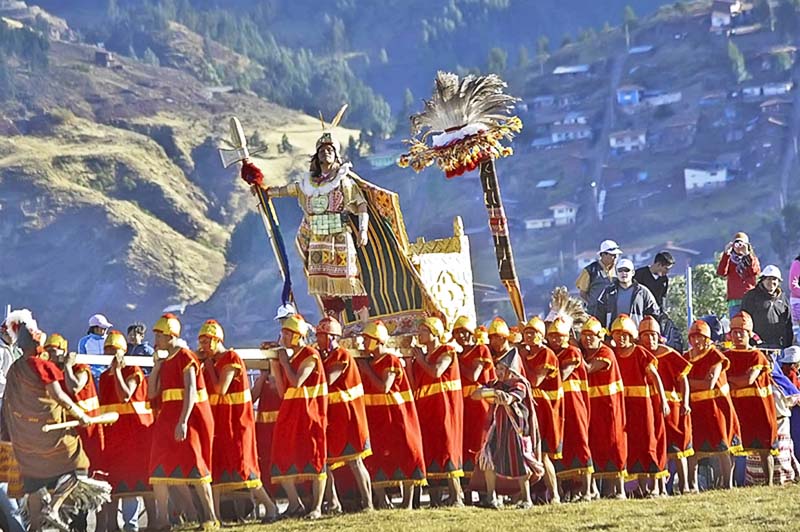
Meet and enjoy some of the most important parties of Cusco during your trip to Machu Picchu
Cusco is the scene of many festivities during the year. Most of them are accompanied by the exquisite cuisine of Cusco. Religious holidays are celebrated with great faith. These have their origin in the colonial and Inca times. The most famous in the world is the Inti Raymi (Sun Festival).
Cusco carnivals
- Carnivals are the most symbolic expression of excitement in the Cusco calendar. Although it is celebrated in all the Andean towns, in Cusco it acquires a particular characteristic for the colorful clothes and the choreographies of its inhabitants.
- Carnivals are celebrated on Sundays in the streets of the city of Cusco. However, also they held in the villages of the Sacred Valley: Pisac, Chinchero, Urubamba, Ollantaytambo, etc .
- Cusqueño carnivals are characterized by dances, water play and the famous yunzas (trees adorned with balloons and gifts for people).
- A week before the central carnival day, the inhabitants of Cusco celebrate the ‘Día de los Compadres’ (amical relationship between men) and the ‘Día de las Comadres’ (amical relationship between women).
Date of the party: Every Sunday in February.
How to go? Visiting Cusco or any town in the Sacred Valley of the Incas.
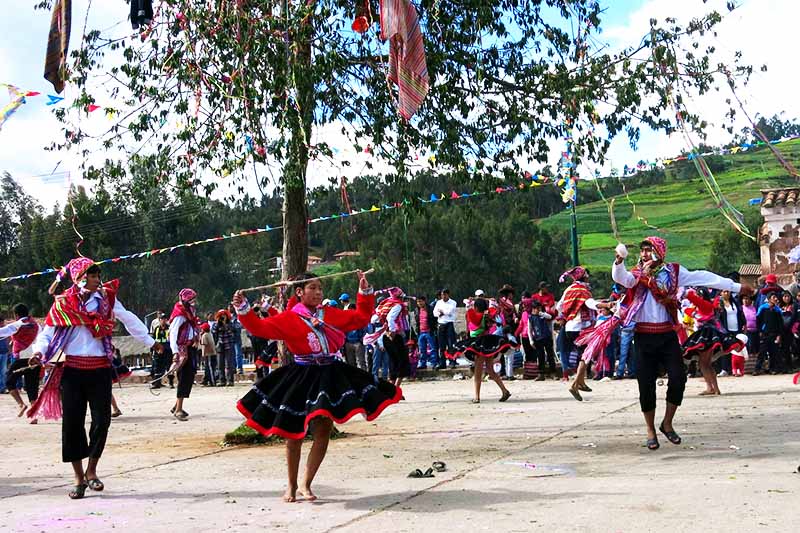
Carnivals in Cusco
Religious festival in honor of the Lord of the Tremors of Cusco
- The Taytacha of the Tremors (Holy of the Tremors in Quechua language) is one of the most important religious images of Cusco. It is an effigy of Jesus Christ crucified that has a dark complexion.
- The Lord of the Tremors is considered the ‘Sworn Pattern of Cusco’. The image stopped a plague in the city after being taken in procession. Likewise, when the city was devastated by earthquakes, the inhabitants of Cusco begged the image to stop the misfortunes. It was thus that he was known as ‘The Lord of the Tremors’.
- Since then and for many years, the image is revered in the Cathedral of Cusco. It is carried in procession every ‘Holy Monday’ in the middle of a large conglomeration of parishioners.
- The procession of the ‘Taytacha de los Tremblores’ is characterized by religious manifestations as well as tasting of Cusco cuisine .
Date of the party: All ‘Holy Monday’.
How to go? Visiting the city of Cusco.
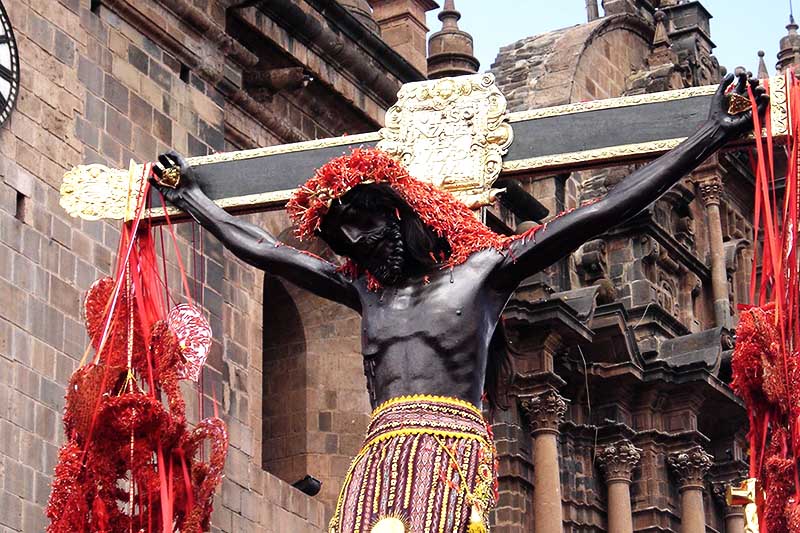
Lord of the Tremors in the procession
Festivity of Corpus Christi
- Corpus Christi is a Christian holiday with indigenous roots that takes place in Cusco every year nine weeks after the ‘Holy Thursday’ . It is characterized by the massive procession of the 15 saints and virgins of the main temples of the city.
- Each image is accompanied by its group of parishioners to the rhythm of music bands. After meeting in the Cathedral of Cusco they are taken in procession through the streets of the city of Cusco.
- The festival of Corpus Christi has its origins in the Inca tradition of bringing the mummies of the Inca rulers in procession. The Spanish, after the conquest, replaced the Inca mummies with Christian images.
- The ‘Corpus Christi’ festival is a massive event in Cusco, whose streets offer a variety of gastronomic dishes such as ‘Churi uchu’ (dish made of guinea pig, chicken, sausage, cheese and other ingredients).
Date of the party: Every year 9 weeks after the ‘Holy Thursday’.
How to go? Visiting the city of Cusco.
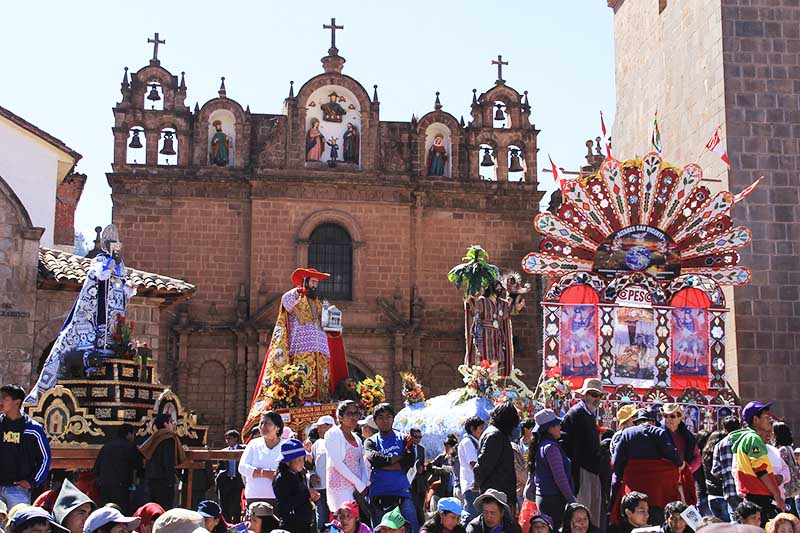
Images of the Saints and Virgins of the main cathedrals of Cusco in procession
Feast and pilgrimage of the Lord of Qoyllur Rit’i
- The Feast of the Lord of Qoyllur Rit’i is one of the most fervent and ancient religious festivals in the Cusco region. It is celebrated in the town of Ocongate (province of Quispicanchis) at the end of May or beginning of June (the date is movable).
- The origins of the image of the ‘Lord of Qoyllur Rit’i are not clear. It is believed that it took place more than 2 centuries ago near the snowy Sinakara . Legend has it that an indigenous boy named ‘Marianito Mayta’ found a sudden friendship with a blond boy. After several days, these were found in the icy snows, one turned into the image of the Lord of Qoyllur Rit’i and the dead indigenous child.
- The pilgrimage of the Lord of Qoyllur Rit’i is the most massive of the Peruvian Andes. It brings together more than 10,000 people to the nearby snows of Ausangate, more than 5,000 meters above sea level (16,400 ft.). There the religious festival is characterized by dances, songs and fervent religiosity.
Date of the party: Every year on Christian Ascension Day.
How to go? Hire a tour on the day of the party or go on your own taking a public transport to the town of ‘Ocongate’.
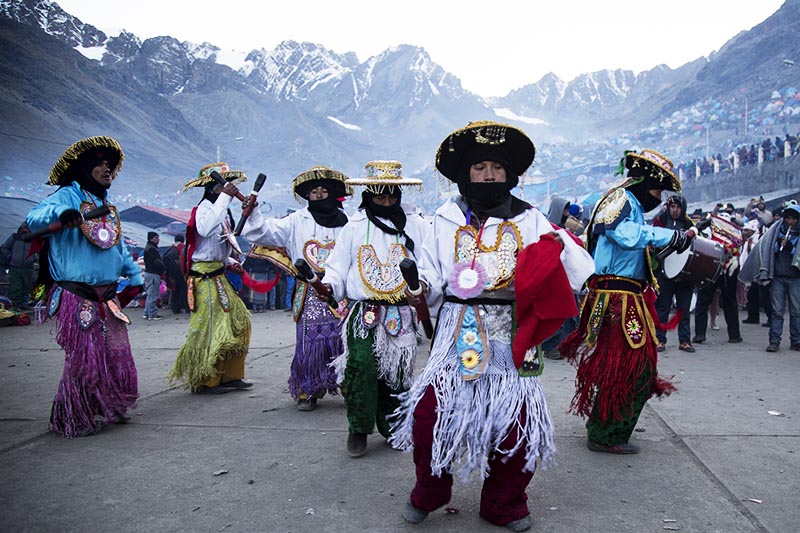
Pilgrim dancers to the Sinakara shrine to see the Lord of Qoyllur Rit’i
Inti Raymi
- The Inti Raymi is the Inca party that worships the sun, the highest Inca deity . It takes place every June 24 during the beginning of the winter solstice.
- This celebration is characterized by claiming the ancient Inca tradition that worshiped the sun god through a massive religious celebration in Cusco. Since 1944, the people of Cusco perform a gigantic staging simulating the Inca tradition in the sacred places: the Coricancha, the Plaza de Armas and the Fortress of Sacsayhuaman.
- During the Fiesta del Inti Raymi, Cusco people take to the streets to celebrate their Inca past through typical dishes, dances and music. Even that day is declared a holiday in the region.
- There are many tourists who come from all over the world to appreciate the staging of the Inti Raymi. Representations in the Coricancha and the Plaza de Armas are free but not the presentation in Sacsayhuaman. This must be acquired through an online tourism agency.
Date of the party: Every year on June 24.
How to go? Visiting the city of Cusco.
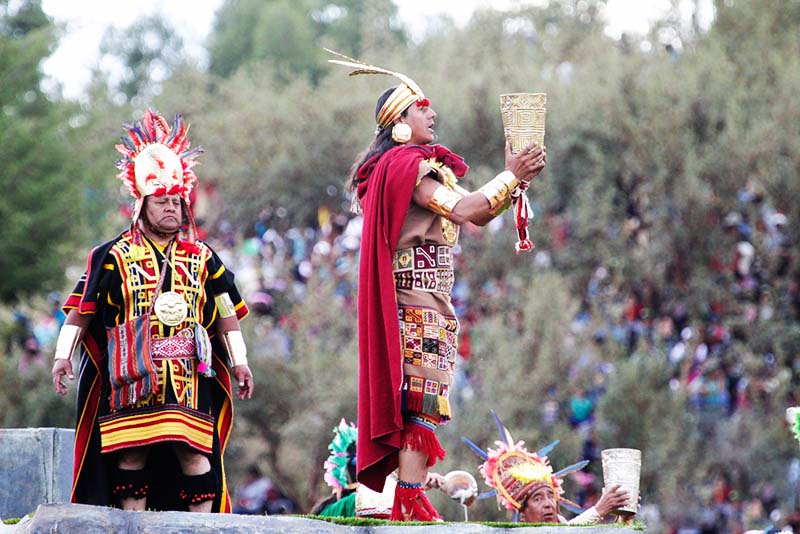
The Inca the full celebration of Inti Raymi
Annual holiday of the Q’eswachaka Bridge
- The peasant communities near the town of Q’ehue celebrate the reconstruction of the Inca bridge of Q’eswachaka every year . This rustic construction is one of the last hanging Inca bridges that are still used in Peru.
- Each year, both men and women from the communities of Huinchiri, Chaupibanda, Ccollana, Q’ehue and Pelcaro work together for four days to replace the old Inca bridge with a new one. The works are accompanied by music, dance and typical Cusco dishes.
- The reconstruction of the Inca bridge is a very popular tourist event. Many visitors are encouraged to cross the suspended Inca suspension bridge 30 meters above the Apurimac River.
- The Q’eswachaka Bridge was considered ‘Cultural Heritage of Humanity’ by Unesco in 2013.
Date of the party: Every year on the second Sunday of June.
How to go? With a tour package or visiting the place on your own by a bus trip to the town of Combapata.
Machu Picchu Anniversary Party
- On July 7, 2007, Machu Picchu was chosen as one of the new wonders of the modern world in a global vote organized by the organization New Open World Corporation.
- The festival is characterized by cultural events in the streets of the town of Aguas Calientes: drawing contests, recitals, dances, music and more.
- At night the population and tourists gather in the stadium of the town of Aguas Calientes for a music concert show with popular groups from Peru..
- The festivities continue until dawn.
- Definitely visiting Machu Picchu and Aguas Calientes on July 7 is a good date to learn more about Peruvian culture.
- Machu Picchu receives more than 1.5 million people every year.
Date of the party:July 7th.
How to go?Through a tour to Machu Picchu or on your own with the train trip to the town of Aguas Calientes.
Feast of the Virgin of Carmen of Paucartambo
- In Cusco there are many religious festivals that worship different images of saints and virgins. One of the most fervent and celebrated festivities is the one that worships the Virgin of Carmen in the town of Paucartambo, located just over 2 hours from the city of Cusco.
- This religious holiday is characterized by the different groups of dancers who worship the image of the virgin through difficult dance and music steps .
- The celebration lasts 5 days where the excitement is general. The central day is July 16, in which all dance troupes take to the streets and plazas mixing with the general public.
Date of the party: July 16 (Central Day).
How to go? Through a tourist package or visiting Paucartambo on your own through a bus trip.
Pachamama’s day
- Every August 1 in all the Andean towns of Peru, Bolivia, Ecuador and Argentina celebrate the ‘Pachamama Day’. This celebration of Inca origin revalues the cult of the ‘Mother Earth’, a sacred entity of those who believed that it has life and rules over the life of the population.
- In Cusco that day the so-called ‘Payments to the earth’ are made . These ceremonies have their origins in the Inca era. It is a ritual of thanks to the ‘Pachamama’, in which coca leaves, chicha, corn and other Andean products are offered.
- While ‘Land payments’ are usually made in the high mountains, it is also possible to do it at home. These rituals are performed by a sorcerer or ‘shaman’ who possesses knowledge about the ritual transmitted by his family.
- Tourists can also participate in the ‘Pachamama Day’ through tour packages that include ‘Land payment’ ceremonies.
Date of the party: Every year on August 1.
How to go? Visiting the city of Cusco or hiring a tour package that includes a ‘Land payment’ ceremony.
Santuranticuy
- One of Cusco’s own cultural expressions is, without a doubt, the traditional festival of Santuranticuy (‘Sale of Saints’ in Quechua language). This holiday is celebrated every December 24 through an artistic fair where images of virgins, saints and other Christian figures with Andean characteristics are marketed.
- This traditional celebration is held in the Plaza de Armas of Cusco, which is filled with people including artisans, local people and tourists.
- In Cusco it is tradition that each family has its own saints or virgins of different sizes. During Santuranticuy these people come to repair their religious images or renew them.
- Among the most important religious images of Cusco, the so-called ‘Manuelitos Children’ stand out, handicrafts with characteristics of the ‘Jesus Child’ .
- That day also offers paintings, ceramics, sourvenirs and even typical dishes of Cusco. At night, Cusco families enjoy a succulent Christmas dinner.
Date of the party: Every year on December 24.
How to go? Visiting the city of Cusco.
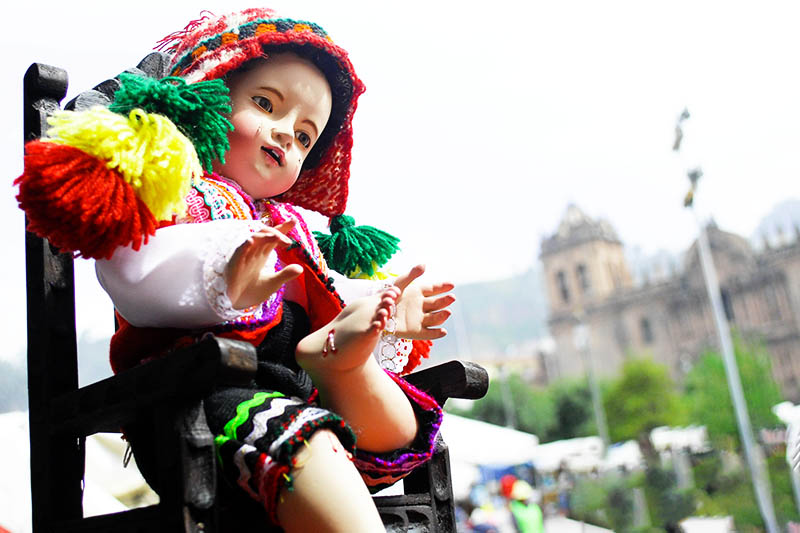
Andean representation of the child Jesus also known as the child of the thorn
New Year in Cusco
- The new year in Cusco and Machu Picchu is a holiday full of joy. Although it has similar characteristics to the celebration that takes place throughout the world, it has its particularities in gastronomy and cabal.
- On December 31, Cusco families enjoy traditional dishes where the piglet stands out (few families prefer to eat turkey) .
- Among the characteristic cabals of Cusco, it is worth visiting the Plaza de Armas counterclockwise. It is also common to see houses surrounded by yellow confetti (this practice symbolizes good luck for the following year).
- After midnight, the nightclubs are filled with foreigners and local people celebrating the new year. Cuzco nights are some of the most fervent and memorable in Peru.
Date of the party: Every year on December 31.
How to go? Visiting the city of Cusco. .
Advice from people who have been there
 By: Veronika E.
By: Veronika E.“Christmas in Cusco!“
“I was on December 23 and it turns out that on the 24th there was a craftsmen's fair, since 23 they are installed, it is an incredible fair with art that impressed me a lot. There are all the prices, I recommend that if you are going to be those days, take advantage of those days to buy because it is worth it “
By Ticket Machu Picchu – Last updated, August 15, 2024